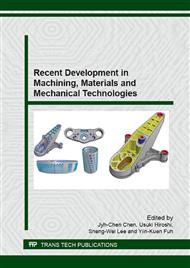p.363
p.369
p.375
p.381
p.387
p.391
p.398
p.404
p.410
The Effect of Eccentricity of the Tool on the Surface Morphology of FSJ Joint
Abstract:
An attempt is made here to join 2024 aluminum alloy plate by friction stir joining (FSJ) using tools with different eccentricity. Joint surface morphology was observed, and the sizes of both arc line spacing and flash were measured. Furthermore, study the effect of eccentricity of the tool on the surface topography of FSJ joint and analyze the formation of the joint surface topography. It is found that, the space trajectory of long axis of shoulder which formed by the eccentricity of the tool determine the morphology of the arc lines; the ratio between the feed speed and the rotation speed determine the arc line spacing; length of time that long axis of shoulder squeeze the edge of the joint line in the advancing side and the retreating side determines the size of flash in both sides of the joint line. Arc lines were regularly distributed in the joint lines and there are also regular texture structure distributed in the flash of each side. The flash in the advancing side is less than the retreating side. Increasing the amount of eccentricity, it has litter effect on the arc line spacing but will destroy the arc lines morphology in the joint surface and promote the formation of filamentous flash structure in the both sides of the joint.
Info:
Periodical:
Pages:
387-390
Citation:
Online since:
July 2015
Authors:
Keywords:
Price:
Сopyright:
© 2015 Trans Tech Publications Ltd. All Rights Reserved
Share:
Citation:


